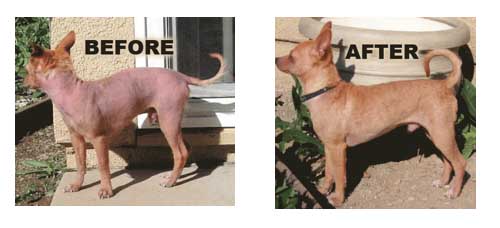Table of Contents
Summary:
"There are different types of canine mange, which is caused by varied mites. Symptoms range from mild to severe, and treatment varies with the type and severity of the mange affecting your dog. Treatment may include prescription or over-the-counter dog mange remedies."
Overview
There are several approaches for mange mite treatment and for addressing the related
symptoms of the infection. There are also several dog health issues that can cause similar symptoms - see this chart to learn more about these.

Sarcoptic Mange Treatment
Sarcoptic Mange symptoms start in areas on the mid-section of the body and the spreads to the ears, areas around the eyes, legs and elbows. Sarcoptic mange causes severe itching, which causes the dog to scratch. The scratching introducing bacteria, causing skin lesions and infection. Eventually the skin starts to wrinkle become thicker. If left untreated the condition spreads to the entire body (called generalized dermatitis).
Since the disease is difficult to treat, a veterinarian will prescribe or recommend one or several treatment methods:
- Dog Mange Home Remedy: Lime-sulfur dips such as Naturasil are F.D.A. approved for mange treatment. They are applied weekly and safe, but have an odor (apply in a well ventilated room). The Naturasil solution mixes with the dog's existing shampoo making the treatment seem familiar to the dog, an advantage due to the strong odor of a dip product. Sarcoptic mange can also be treated at home with a spot-on and spray that contains fipronil such as Frontline.
Prescription Remedy: A veterinarian can prescribe Ivermectin for 14 days using 3 to 4 treatments. Note that some breeds such as Collies should not be given Ivermectin due to sensitivity. Mibemycin oxime is another oral medication given for 1 or more weeks.
When treating Sarcoptic Mange you should wear gloves since the mites can cause problems for humans for several days, after which they cannot survive.
For additional support consider adding a homeopathic formulated to speed skin and coat healing such as Skin and Coat Tonic.
Demodectic Mange Treatment
Demodectic Mange (also called red mange and demodex) can result in "coin" shaped spots on the body (usually up to 5), usually on the face around the eyes or nose. Itch isn't as much of a problem as it is for sarcoptic mange.
Frequently seen in dogs age 3
months to 1 year, or in dogs with a disease that depresses the immune
system, the mite population starts to
grow causing mange all over the dog's body.
- Home Remedy For Mange: If the mange is causing problems in just a few spots, wait and see if it heals on its own. That said, a dip such as the Naturasil mentioned above or a medicated shampoo can help to speed treatment and recovery.
For generalized mange where it is all over the body, you can try an over the counter dip such as Naturasil.
- Prescription Remedies for Mange: If demodetic mange has caused a generalized problem (all over the body), the a prescription dip such as Mitaban® (amitraz active ingredient) may be required. The dip is applied every 1 to 2 weeks in a concentration of .025 to .125% depending on the vet's recommendation. Treatment continues for 4 weeks after skin tests show that all mites have been killed.
Treatment can take several months. An alternative treatment for
demodectic mange in dogs is increasing the number of prescription dip
treatments, the oral medication Milbemycin oxime for 2 to 3 months or
oral Ivermectin for 2 to 3 months.
References for Treatment Mange Mites in Dogs
External Parasitic Diseases of Dogs and Cats
P.A. Payne, M.W. Dryden (1,2) , G.R Carter (3)
1,2: Department of Diagnostic Medicine-Pathobiology, College of Veterinary Medicine, Kansas State University, KS, USA
3: Department of Biomedical Sciences and Pathobiology,
Virginia-Maryland Regional College of Veterinary Medicine, Virginia
Tech, Blacksburg, Virginia, USA

